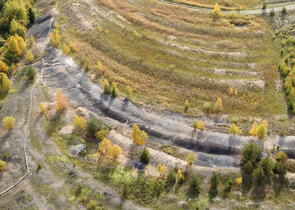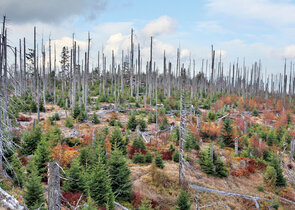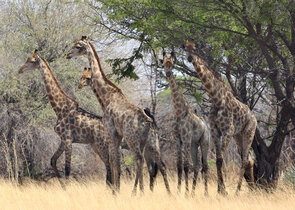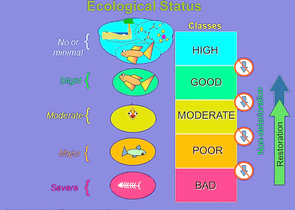The Landscape of Cooperation – Forty Years of the Bílé Karpaty/White Carpathians Mts. Protected Land

What comes to mind when you hear the word the Bílé Karpaty/White Carpathians Mts.? A hundred years ago it was still the most remote corner of the Czech Republic, from which people were leaving for America to find a job. Today it is a popular destination for an increasing number of visitors of the entire country. Everyone will come up with something else – probably most often meadows full of orchids stretching to the horizon, but also (from west to east) wine cellars near the municipality of Petrov and the town of Strážnice, old service/sorb trees (Sorbus domestica), the Horňácko/Upper Moravian Slovakia region folk culture, the Moravian Kopanice region with the Goddesses of Žítková, the virgin forest below the top of Mt. Velká Javořina/Great Maple Forest, beech forests in the Vlára Pass, or the well-preserved landscape of Southern Moravian Wallachia around the municipality of Nedašov. The landscape and nature of the picturesque mountains on the Slovak border has really extremely many faces.
Nature Conservation 2022 — 25. 5. 2022 — On Nature in the Czech Republic — Print article in pdf
What Attract Rare Invertebrates to Brown Coal Spoil Heaps?

The lunar landscape image of coalmine regions keeps clinging to people’s minds, despite the fact that a lot of good has happened since the boom of brown coal surface mining below the Krušné hory/Ore Mountains (northwestern Bohemia). Mining companies are in good faith fulfilling their mining obligations including the reclamation of spoil heaps and residue pits in extensive surface quarries as is imposed by law, primarily the Mining Act, the Forest Act and the Act on the Protection of Agricultural Land. An area of more than 12,000 hectares has already been technologically and biologically reclaimed, and at least CZK 20 billion (EUR 0.8 billion) have been invested there (figure converted to today’s value of the Czech Crown based on common reclamation prices) from the miners’ financial reserves as well as governmental resources (see www.15miliard.cz).
Nature Conservation 2022 — 25. 5. 2022 — On Nature in the Czech Republic — Print article in pdf
Which Forest Is Formed by Spontaneous Processes in the Šumava/Bohemian Forest Mts.?

The thirty years of the Šumava/Bohemian Forest Mts. National Park (NP) have provided many findings – due to natural disturbances. European spruce bark beetle (Ips typographus) outbreaks culminated in 1996–1997 and 2009–2010, leading to a mass Norway spruce (Picea abies) decline in 1997 and 2011. But the European spruce bark beetle has left its traces until today, although to a lesser extent, just like a range of hurricanes. The result is that a quarter of the NP’s non-intervention area (approx. 18,000 hectares until 2019) is formed by stands with dead trees. Non-forest areas and peat-bogs account for about 22% and variously old stands dominated by spruce for the remaining 53%. The world of large spruce temples with tall column trunks has changed rapidly in a part of the territory.
Nature Conservation 2022 — 25. 5. 2022 — On Nature in the Czech Republic — Print article in pdf
Uranium Spoil Heaps near the Town of Příbram as a Part of Cultural Landscape Heritage and a Threaten

Mineral mining has had a long tradition as an important national economy sector in the Czech Republic. Sites disturbed by mining have become an integral part of the landscape in many regions. The most altered sites include quarries, dumps and heaps, sand- and gravel pits, kaolin mining sites, and slag and fly ash tailing ponds. The traditional negative view of sites affected this way has rapidly been changingamong experts. Early successional (development) stages and diverse habitats with extreme conditions and low productivity, common at such sites, often serve as substitute habitats for many species disappearing from the landscape in the Czech Republic. Several studies demonstrating the considerable conservation potential of these sites come from the Czech Republic.
Nature Conservation 2022 — 25. 5. 2022 — On Nature in the Czech Republic — Print article in pdf
The Jizerskohorské bučiny / Jizera Mountains Beech Forest National Nature Reserve – A Part of the Wo

It would not be far from the truth to say that in summer 2021 the Jizerské hory/Jizera Mountains Beech Forest National Nature Reserve (NNR) became the most often mentioned Specially Protected Area in mass media in the Czech Republic. In July 2021, the NNR was inscribed on the prestigious UNESCO World Heritage List becoming a new component of the serial World Heritage Site Ancient and Primeval Beech Forests of the Carpathians and Other Regions of Europe (Plesník & Hušek 2021). Because in previous articles we have provided only a brief description of the NNR and have paid attention more to its nomination and approval (Plesník & Hušek 2020, Plesník 2020) it is quite appropriate to present the extraordinary site not only from a point of view of nature and landscape heritage protection, conservation and management in more detail.
Nature Conservation 2022 — 25. 5. 2022 — On Nature in the Czech Republic — Print article in pdf
Preface Anna Hubáčková issue 2022

Dear friends, dear readers,
You have got another issue of Ochrana přírody/Nature Conservation Journal presenting the selected articles published there in 2021 describing approaches of nature conservation in the Czech Republic, in both national and international contexts.
Nature Conservation 2022 — 25. 5. 2022 — Preface — Print article in pdf
A Feasibility Study on:

One of the significant preconditions for enhancing and improving nature conservation, biodiversity protection respectively in protected areas is ecotourism development, undoubtedly strengthening job opportunity/employment and economic prosperity in the countryside and at the same time also local community involvement in nature conservation (Eagles et al. 2002).
Nature Conservation 2021 — 10. 6. 2021 — International Nature Conservation — Print article in pdf
Introducing a Transboundary Socio-economic Monitoring Scheme in the Šumava and Bavarian Forest Mts.

National parks are large, specially protected areas. They aim to protect natural ecosystems, support undisturbed natural processes, as well as human-determined biodiversity. However, as the national park mission, in addition to the above mentioned, also includes enabling sustainable development, national park management authorities urgently need to ensure long-term monitoring of the fulfilling both the conservation goals and the mission. A transboundary project of the administrations of the Šumava/Bavarian Forest Mts. has mainly addressed the latter point.
Nature Conservation 2021 — 10. 6. 2021 — Focusing on the Public — Print article in pdf
How We Do (not) Implement the Water Framework Directive in Improving the Morphological Status of Wat

Data show that, in the 1990s, 28.4% of the total length of the Czech Republic’s watercourses were unfavourably modified, which is tens of thousands of kilometres of the river network. According to the current National Biodiversity Strategy of the Czech Republic, the country’s current optimistic targets are at least 300 km of restored watercourses for the 2016–2025 period. The status of watercourses and related floodplains has therefore not seen any significant improvement since the 1990s. Compared with biological and physical/chemical quality elements, monitoring and enhancement of the morphological status of the country’s watercourses has enjoyed a less significant position in the long term. However, apart from the “aesthetical” point of view, its improvement is also of unquestionable importance in terms of water retention in the landscape, flood protection, and drought management. It is therefore a topical issue in society.
Nature Conservation 2021 — 10. 6. 2021 — Research, Surveys and Data Management — Print article in pdf
The Latest Epigraphic Research Has Shifted back the Age of the Oldest Cave Drawing Traces in the Cze
Since 2016, epigraphic research has been carried out in the caves of the Moravský kras/Moravian Karst (South Moravia), with the participation of the Cave Administration of the Czech Republic (CACR), Palacký University Olomouc (PU), and the Nuclear Physics Institute of the Czech Academy of Science Prague (NPI CAS). In 2019, the surprising results of radiocarbon dating of some black charcoal drawing traces in the Kateřina Cave had revealed them to be of prehistoric age (approx. 6,300 years). For more details, see Ochrana přírody/Nature Conservation Journal, 74, 5, 39-41, 2019. During detailed documentation of these objects, some other interesting clusters of lines and shapes were discovered there. Analysis of one of them revealed that they are even older, namely more than 7,000 years.
Nature Conservation 2021 — 10. 6. 2021 — Research, Surveys and Data Management

